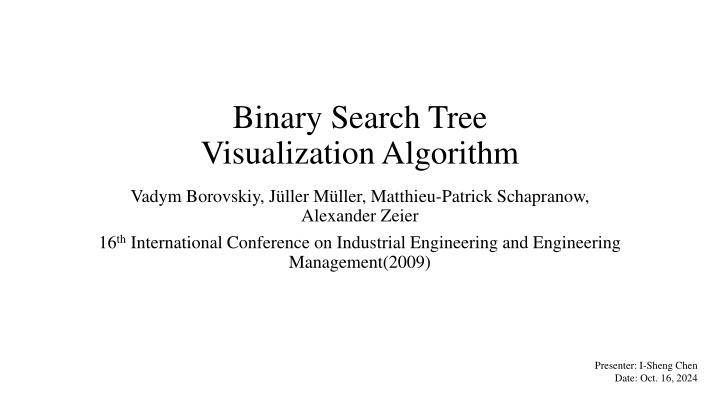
Efficient Visualization Algorithms for Binary Search Trees
Discover innovative algorithms for visualizing Binary Search Trees efficiently, aiding programmers in comprehending large BST structures. Explore techniques like Fixed and Floating Coordinates along with their advantages and disadvantages.
Download Presentation

Please find below an Image/Link to download the presentation.
The content on the website is provided AS IS for your information and personal use only. It may not be sold, licensed, or shared on other websites without obtaining consent from the author. If you encounter any issues during the download, it is possible that the publisher has removed the file from their server.
You are allowed to download the files provided on this website for personal or commercial use, subject to the condition that they are used lawfully. All files are the property of their respective owners.
The content on the website is provided AS IS for your information and personal use only. It may not be sold, licensed, or shared on other websites without obtaining consent from the author.
E N D
Presentation Transcript
Binary Search Tree Visualization Algorithm Vadym Borovskiy, J ller M ller, Matthieu-Patrick Schapranow, Alexander Zeier 16thInternational Conference on Industrial Engineering and Engineering Management(2009) Presenter: I-Sheng Chen Date: Oct. 16, 2024
Abstract Binary search tree is a very common data structure in computer programming. Working with large BSTs can become complicated and inefficient unless a programmer can visualize them. This article contributes with two BST visualization algorithms that draw a tree in time linearly proportional to the number of nodes in a tree.
Drawing BST with Fixed Coordinates(1/4) (i) The root is always drawn in the (0,0) (ii) The row index i of any child equals to that of its parent plus 1 (iii) The column index j of a left child equals to doubled column index of its parent, and for the right child j equals to the index of the left child plus 1.
Drawing BST with Fixed Coordinates(2/4) The algorithm requires a canvas of the size : Canvas width = ?? 2???? ??? ? Canvas height = hc TreeHeight The width of compartments at other levels : Wi= ?? 2???? ??? ? ?
Drawing BST with Fixed Coordinates(3/4) xc = 2 ?? + 1 ?? 2 ?? 1) // X yc = 2 ?? + 1 ? 2// Y (3) (?? 2, 5 ? 2, 5 * ? 2) => (2,0) (7) (3 * ?? 2) => (2,1) (5) (wc , 3 * ? 2) => (1,0) 2, 5 * ? (15) (5 * ?? 2) => (2,2) (20) (3 wc , 3 * ? 2) => (1,1) (10) (2 * wc , ? 2) => (0,0)
Drawing BST with Fixed Coordinates(4/4) Disadvantage: but it has a serious disadvantage. It uses a canvas in the least efficient way. If a tree is close to balanced or even complete this deficiency becomes less obvious. However, if we add only one node to the tree, the algorithm will require a canvas two times as wide as the current one.
Drawing BST with Floating Coordinates(1/3) Postorder Traversal Left: (oX, oY + hc) right: (oX+w, oY + hc) Horizontal offect: ( ) w=stW w+=stw rX = oX+stW-d/2 vertical offset: oY =oY+hc
Drawing BST with Floating Coordinates(1/3) Leaf: w=d rX = oX rX = oX+stW-d/2 (3) (0 , 5 ? ? ) => (2,0) 2 (7) (? , 5 ? ? ) => (2,1) 2 (5) (? 2, 3 ? ? ) => (1,0) 2 (12) (2? , 5 ? ? ) => (2,2) 2 (15) (5 2? , 3 ? ? 2? , ? ? ) => (1,1) 2 (10) (3 2) => (0,0)
Drawing BST with Floating Coordinates(3/3) The algorithm requires a canvas of the size : Canvas width <= (?? (?+1)) 2 Canvas height = ? TreeHeight
Conclusion Fixed Coordinates Time Complexity: O(n) Floating Coordinates Time Complexity: O(n)
